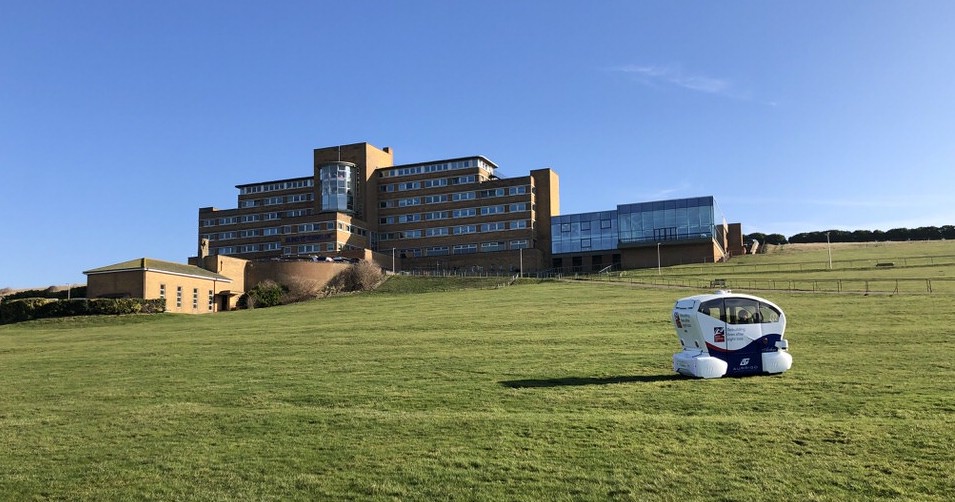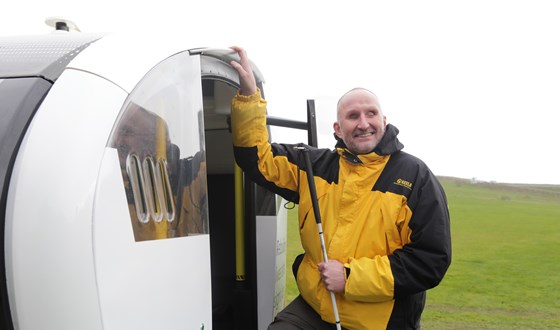


In the culmination of a world-leading research project, St Monica Trust residents have taken part in a demonstration to see how driverless vehicles could make a difference to their everyday lives
The demonstration at the Trust’s Cote Lane retirement village saw participants experience a journey in an Aurrigo Pod Zero, a first production line model of connected and autonomous vehicles (CAVs).
Open to people aged 65 and over, the physical demonstration lasted around 10 minutes before attendees were invited to provide feedback on their experience.
A safety ‘driver’ accompanied up to three participants at a time on a planned journey around the site.
Open to new technologies
Sara Naylor-Wild, Director of Development and Research at St Monica Trust, commented: “We have a long-standing relationship with UWE Bristol, especially around technology and assisted living.
“At the St Monica Trust we are constantly continuing to develop our thinking with what we can offer our residents to ensure they live their best lives.
“When we were given the opportunity to host this demonstration it was a no brainer for us, our residents are open to new technologies and they certainly rose to the challenge.
“The demonstration has been thrilling, it’s such an exciting opportunity and the residents have met it with such enthusiasm.”
Flourish
The £5.5M project, known as ‘Flourish,’ is run by a multi-sector consortium of organisations including the University of the West of England (UWE Bristol) and is the only Innovate UK funded project focused on older people.
The project launched in 2016 with an aim to develop a driverless vehicle that integrates the mobility needs of older people with a secure and connected infrastructure.
The introduction of CAVs could revolutionise mobility for older people, reducing loneliness and helping them to maintain a healthy level of independence.
It is anticipated the pods could be in operation on enclosed campuses like retirement villages within five to ten years.
UWE Bristol
The Flourish project works across three specialist areas at UWE Bristol, which is running the event at the St Monica Trust village.
These are the Bristol Robotics Laboratory, the Centre for Transport and Society and the Psychological Sciences Research Group.
This group of specialists has helped the research project cover the science behind driverless vehicles, the UK’s future transport requirements and the psychology behind how humans interact with and what they want from CAVs.
Valuable insight into how older people feel
The project team decided to work with the St Monica Trust due to their like-minded dedication to introducing innovative technologies into their retirement villages that encourage and facilitate independence in later life.
Dr Chris Alford, Associate Professor in Applied Psychology at UWE Bristol, said: “Today’s event was a perfect way to conclude the Flourish project – with a demonstration of how pods could be used to transport older people, and those with limited mobility, within their home environment.
“Our project team has been able to gather a high quantity of useful feedback from St Monica Trust residents, offering a valuable insight into how older people feel about the concept of driverless vehicles and the types of user interfaces that might work best for them.
“Flourish is unique in being focused on older people, who will be among the first to benefit from the private and community availability of driverless transport.
The project has shown that driverless vehicles have the potential keep older people engaged in their communities and in touch with their family and friends.”
Freedom to plan days out
The design of the vehicles has been the result of a period of consultation with older people to identify what older people want from driverless vehicles and the vision for their future use.
The consultation process has included older people visiting a simulator in a robotics lab and various workshops and discussion groups.
The research to date, supported by Bristol City Council and South Gloucestershire Council, has found that older people have an acceptance of these vehicles and that they wish for the cars to become commonplace in order to have the freedom to plan days out, pick up grandchildren as well as run day-to-day errands.
Human machine interface
The project has also considered the design of the cars to ensure they meet requirements.
This has included studying how older people interact and operate the vehicles using a human machine interface (HMIs) and adapting them to allow for impaired vision, loss of hearing, restricted mobility, poor movement control and issues with balance and difficulties with speech, memory and attention.
Following the demonstration event, the team will publish a report this summer and develop a standardised assessment framework that will help determine the individualised adaptations needed for older people and people with disabilities to introduce these vehicles into their everyday lives.
UNIT 33 BILTON INDUSTRIAL ESTATE
HUMBER AVENUE, COVENTRY, CV3 1JL. UK
0044 (0)24 7663 5818